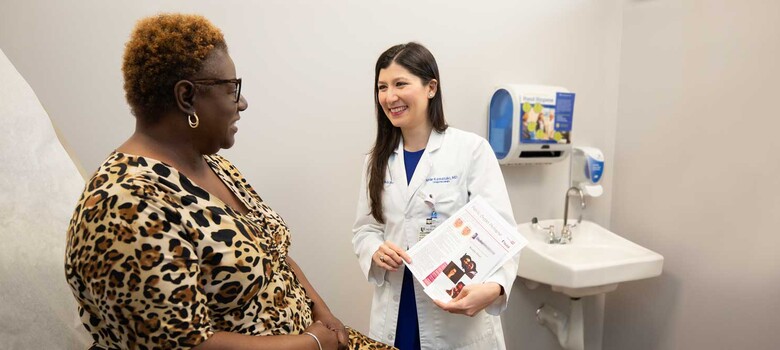 From the DukeHealth.org archives. Content may be out of date.
From the DukeHealth.org archives. Content may be out of date.
Opening Up About Vaginal Prolapse

Nobody wants to talk about vaginal prolapse, but that’s exactly why LaRue Dedrick of Durham was willing to open up about her experience. “I never heard of it, or heard anybody discuss it. I had no clue how frequently it happened or to how many women.” By talking about it, Dedrick hopes more women will get the help they need.
What is Vaginal Prolapse?
The vagina and other female pelvic organs -- uterus, rectum, small bowel and bladder -- are held in place by muscles, ligaments and tissues. When they become weak or break, one or more of these organs can prolapse, or drop from their normal positions, explained Amie Kawasaki, MD, a Duke urogynecologist. Without treatment, the prolapsed organs can eventually push the vaginal walls out through the vaginal opening.
“It felt like I had a tampon coming out all the time,” said 65-year-old Dedrick. “It wasn’t painful, but it was uncomfortable and a nuisance. The vaginal wall would fall down and I’d have to keep pushing it back in. It was definitely a quality of life issue.”
After consulting with her primary care doctor, Dedrick went to see Dr. Kawasaki, one of five board-certified urogynecologists at Duke who specialize in pelvic organ prolapse and other pelvic floor disorders.
Choosing the Right Treatment for Prolapse
A woman’s personal discomfort helps determine which treatment is right for her, explained Dr. Kawasaki. Sometimes, a good first step is simply understanding what’s happening, and learning exercises from a pelvic floor therapist that protect and strengthen the pelvic floor.
Women who are moderately bothered by prolapse but aren’t ready for surgery may opt for a vaginal pessary. The small silicone device is available in several shapes and sizes. It is inserted into the vagina to provide structural support. Dr. Kawasaki compared its function to a girdle. “You wear a girdle to make you feel more comfortable but it won’t change your anatomy.” Pessaries can be a lifetime or temporary solution, depending on the woman’s needs.

A woman’s personal discomfort helps determine which treatment is right for her.
Surgical Options for Vaginal Prolapse
Surgery can be performed either through the vagina or through an abdominal incision. During laparoscopic and robotic versions of the procedure, tiny instruments are passed through small, abdominal incisions, Dr. Kawasaki said. These approaches may involve the use of a Y-shaped mesh that is fixed in place and used to reinforce the vaginal walls.
“Our practice has been involved in national studies regarding mesh products,” Dr. Kawasaki said. “We have carefully selected mesh products and surgeries that are proven to be safe for our patients. This procedure maintains some of our longest and highest success rates.”
Non-mesh options involve the use of a woman’s own body tissue. “We connect points of the vagina up to ligaments on the pelvis with long-lasting suture materials,” she explained.
Women who are no longer sexually active, elderly or have medical problems may opt for a surgery “where we actually close the vagina,” Dr. Kawasaki said.
Fast Recovery, Feeling Great
Dedrick opted for the laparoscopic mesh procedure, known technically as a sacrocolpopexy.
“It worked out very well for me,” said the retired pharmacist. “I had very little pain after the surgery and recovery was fast. I really dreaded and was nervous about the surgery, but I just didn’t want to deal with this for the rest of my life. Now, I’m sorry I wasted my time worrying about it at all. I feel great. I would recommend it to anyone with this problem.”

My whole goal is to get my patients back to the activities they want to do,” said Amie Kawasaki, MD.
Women Still Unaware of Treatment Options
Unfortunately, many women don’t know such treatments exist. And it’s not uncommon for women to tell Dr. Kawasaki they’ve been experiencing discomfort for up to seven years.
“A lot of times they don’t mention it to a doctor because they think it’s a part of aging or the normal thing that happens after you have babies,” Dr. Kawasaki said.
Protect Your Pelvic Health
Many factors can increase your risk for pelvic floor disorders such as prolapse. “We can’t change our genetics, we can’t change prior pregnancies or methods of childbirth,” said Dr. Kawasaki. “But we can take steps to decrease our risk for pelvic floor disorders, and protect our pelvic health.” They include:
- Don’t smoke. Smoking can weaken the muscles, ligaments and tissues that support the pelvic organs.
- Do pelvic floor exercises. Learn to relax and tighten the muscles that support the vagina and pelvic organs. A pelvic floor therapist can help you do this and other exercises correctly.
- Avoid chronic constipation, straining and coughing which can stress the pelvic floor.
- Seek treatment as soon as the condition bothers you.
“My whole goal is to get my patients back to the activities they want to do,” said Dr. Kawasaki.



